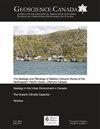in the Persian Gulf
IF 0.8
4区 地球科学
Q3 GEOSCIENCES, MULTIDISCIPLINARY
引用次数: 0
Abstract
Some months ago I received from Dr. J. Cosmo Melvill a small box containing brachiopods from the Persian Gulf. These had been obtained by Mr. F. W. Townsend in the course of his dredgings for Mollusca in that region. The locality on the box containing the specimens is Dabai, which lies within the Persian Gulf on the N.W. coast of Oman. Its exact position is on the west side of the peninsula of Ruus El Jibal, on what is known as the Pirate Coast. Unfortunately, no particulars as to depth etc. accompanied the specimens. With the exception of the Mollusca and some Madreporarian corals very little appears to be known of the fauna of the Persian Gulf. The Mollusca have been ably dealt with in a series of papers by Messrs. Melvill and Standen*, and the corals were described in 1911 in a paper by Miss Ruth Harrison "f, to which Professor S. J. Hickson added some further notes J. The discovery of Brachiopoda in the Persian Gulf is of very great interest, not only from the fact that these specimens are the first of the class to be recorded from this region — i. e., the N.W. corner of the Indian Ocean (including the Persian Gulf, Gulf of Oman, and Arabian Sea), — but more especially from the important bearing of these specimens on the subject of the relation of the fauna of the Persian Gulf to that of the Mediterranean Sea and Atlantic Ocean. Four specimens only were present in the box, one of which is a Terebratulina, the other three belonging to the genus Muhlfeldtia. All are dead empty shells, and a small quantity of greyish marl was present in the interior of one or two. Unfortunately , in the case of the Terebratulina, the brachidium, or loop, is broken, but the shell is otherwise quite perfect, both valves being present. In form and size it is very like a specimen of Terebratulina caput-serpentis figured by Fischer and Oehlert from the ' Talisman ' Expedition in the Lusitanian Subregion §. It has the same general outline and is cut off在波斯湾
几个月前,我从J. Cosmo melville博士那里收到了一个小盒子,里面装着来自波斯湾的腕足类动物。这些是f·w·汤森先生在那个地区为软体动物进行疏浚时获得的。装标本的盒子上的地点是大拜,它位于阿曼西北海岸的波斯湾内。它的确切位置在Ruus El Jibal半岛的西侧,被称为海盗海岸。不幸的是,这些标本没有关于深度等细节。除了软体动物和一些珊瑚外,人们对波斯湾的动物群所知甚少。在梅尔维尔先生和斯坦登先生的一系列论文中,对软体动物进行了巧妙的研究*,1911年露丝·哈里森小姐的一篇论文中对珊瑚进行了描述,s·j·希克森教授在论文中补充了一些进一步的注释。J.在波斯湾发现腕足动物引起了极大的兴趣,不仅因为这些标本是该地区首次记录到的同类标本也就是说,印度洋的西北角(包括波斯湾、阿曼湾和阿拉伯海),但更重要的是,这些标本对波斯湾动物群与地中海和大西洋动物群的关系这一主题的重要意义。盒子里只有四个标本,其中一个是Terebratulina,另外三个属于Muhlfeldtia属。所有的都是死的空壳,有一两个的内部有少量的灰色泥灰岩。不幸的是,在Terebratulina的情况下,腕足或环被破坏了,但外壳在其他方面非常完美,两个瓣膜都存在。在形状和大小上,它很像一个由Fischer和Oehlert在卢西塔尼亚分区的“护身符”探险队中发现的Terebratulina caput- serentis标本。它有相同的大致轮廓,并被切断
本文章由计算机程序翻译,如有差异,请以英文原文为准。
求助全文
约1分钟内获得全文
求助全文
来源期刊

Geoscience Canada
地学-地球科学综合
CiteScore
3.30
自引率
0.00%
发文量
9
审稿时长
>12 weeks
期刊介绍:
Established in 1974, Geoscience Canada is the main technical publication of the Geological Association of Canada (GAC). We are a quarterly journal that emphasizes diversity of material, and also the presentation of informative technical articles that can be understood not only by specialist research workers, but by non-specialists in other branches of the Earth Sciences. We aim to be a journal that you want to read, and which will leave you better informed, rather than more confused.
 求助内容:
求助内容: 应助结果提醒方式:
应助结果提醒方式:


